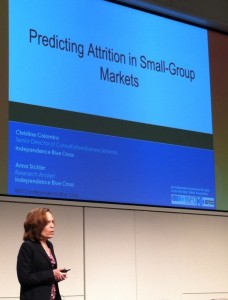I am at the 9th Annual SAS Health Care and Life Sciences Executive Conference, an extraordinary event that draws the best and the brightest leaders as both speakers and attendees from the pharmaceutical, health insurance, health care and related industries. One session featured speakers from Independence Blue Cross sharing their experiences in predicting attrition in the small group market. Christine Colombo, Senior Director of Informatics and Consultative Business Services presented along with Anna Sickler, Research Analyst.

Colombo leads a team that consults with functional areas within Independent Blue Cross (IBC), as well as customers and providers, to improve performance using data and analytics. This includes program design and evaluation, risk stratification, marketing models, predictive modeling and analytics, and return on investment studies. Sickler is responsible for marketing analytics and has experience in data mining, predictive analytics and segmentation analytics. Since joining Independence Blue Cross, she has helped increase membership by building and implementing predictive models.
The path to using customer analytics began with a request from the marketing department, hoping to gain a profile of individuals most likely to enroll in individual coverage. Their initial models used a combination of both internal and external marketing data, with the goal to improve on the previous work done by an external vendor. That project resulted in driving enrollment rates that were double of what the vendor was getting.
Those encouraging results paved the way to applying the same methodology to the small group segment. In that market, customer retention rates had been declining, so the goal was to create a model that would predict the likelihood of small group customers to terminate.
They focused on 2010 customers with a group size of 2 - 50 individuals, and they found that the segment had about 24,000 customers. They approached their model with two samples - one for development and one for validation (which is used to show the true results) and they were able to identify key predictors of their cancellation. Membership metrics were averaged at the customer level, and then they used a logistic regression model and group customers with membership in 2011 were scored and used as targets.
The models had seven variables, and two variables were found to be significant when predicting termination: group size (lower number of subscribers had a higher rate) and lower risk scores. Other factors showed that customers with lower premiums and lower tenure also had a higher attrition rate.
As a direct result of using customer analytics, marketing at Independence Blue Cross will be more effective because they will drive forward-looking behavior. They will score customers with upcoming renewals and communicate it through regular reporting. Once they have the data, they will be able to identify the target segments and tailor the communications with those segments with meaningful messages.
They will be able to tailor their marketing in this way through indirect channels, such as brokers and producers, as well as direct channel outreach with messages that might highlight different products, or emphasize value, based on the profile of the segment.
The experience of Independence Blue Cross is a great illustration of how the use of customer analytics can drive excellent business results. During the Q&A at the end of the session, one audience member said that as a marketer, if they were able to achieve a doubling of results with this kind of collaboration with their internal analytics group, they would quickly become their new best friends. I'd love to hear any other stories of data-driven friendships marketers are building. I know they're out there...
